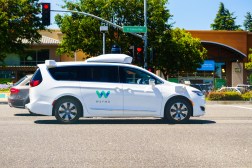Connected-vehicle platoons still aren’t completely legal in 41 states

Traffic is what drove Elon Musk to found the Boring Company, the idea being that without a straightforward solution to today’s gridlock, maybe it can be circumvented with subterranean trains. But if states change their laws to permit tightly packed platoons of autonomous or connected vehicles, a solution might already be within reach topside, says a report published Wednesday by libertarian think tank the Competitive Enterprise Institute.
The 64-page report concludes that a highly variant collection of state “follow too close” or “FTC” laws stand in the way of getting vehicle platoons on the road. Researchers say those laws need not apply to such packs of cars, because their technology allows them to safely synchronize acceleration and braking.
Beyond the uneven criteria and legal terminology that states use to judge what “too close” means, a majority of states have not taken any steps toward exempting autonomous vehicle platoons from existing statutes — 34 states have not provided rule exemptions, nine have fully authorized platooning, while seven have authorized platooning in some form, but still maintain restrictions that researchers deemed “unnecessary.”
In some of the states where platooning has been authorized — Oregon, Nevada, Utah, Louisiana, Wisconsin, Michigan, Indiana, Tennessee, and Georgia — platoon operators are additionally required to submit plans to the transportation department, public safety agencies, or both, before operating.
In the states without platooning exemptions, the regulatory landscape is mixed. Four types of FTC laws use either physical distance, time, of the subjective descriptions of “sufficient space to enter and occupy without danger” and “reasonable and prudent,” which researchers say leave a wide window of interpretation in the hands of law enforcement. Laws also vary depending on the type of vehicles they’re being applied to — the report’s authors note that while platooning promises to reduce passenger vehicle traffic, it also holds potential for new efficiencies in the freight industry.
“Platooned vehicles can travel more closely together at highway speeds, mitigating traffic congestion, improving fuel economy, and increasing vehicle throughput without costly roadway capacity expansions,” the report states.
A 2016 report out of MIT shows that platooned freight vehicles in the middle of a pack could reduce fuel consumption by as much as 20 percent, and that as the technology advances, trucks could follow as closely as nine feet.
And stop-and-go traffic propagated by human drivers could be reduced by 99 percent with the introduction of autonomous vehicles that comprise just 5 percent of all vehicles on the road, according to research published out of Rutgers University-Camden in February.
Ultimately, transportation technology policy is traditionally driven almost entirely by safety considerations, and new laws and exemptions are typically passed with the hope that technologies like connected and autonomous vehicles might help reduce persistent roadway fatality figures. The National Highway Traffic Safety Administration reported last year that deaths on U.S. roads in 2016 reached 37,461, a 5.6 percent increase over the previous year. There were also 5,987 pedestrian fatalities, the highest figure since 1990.





